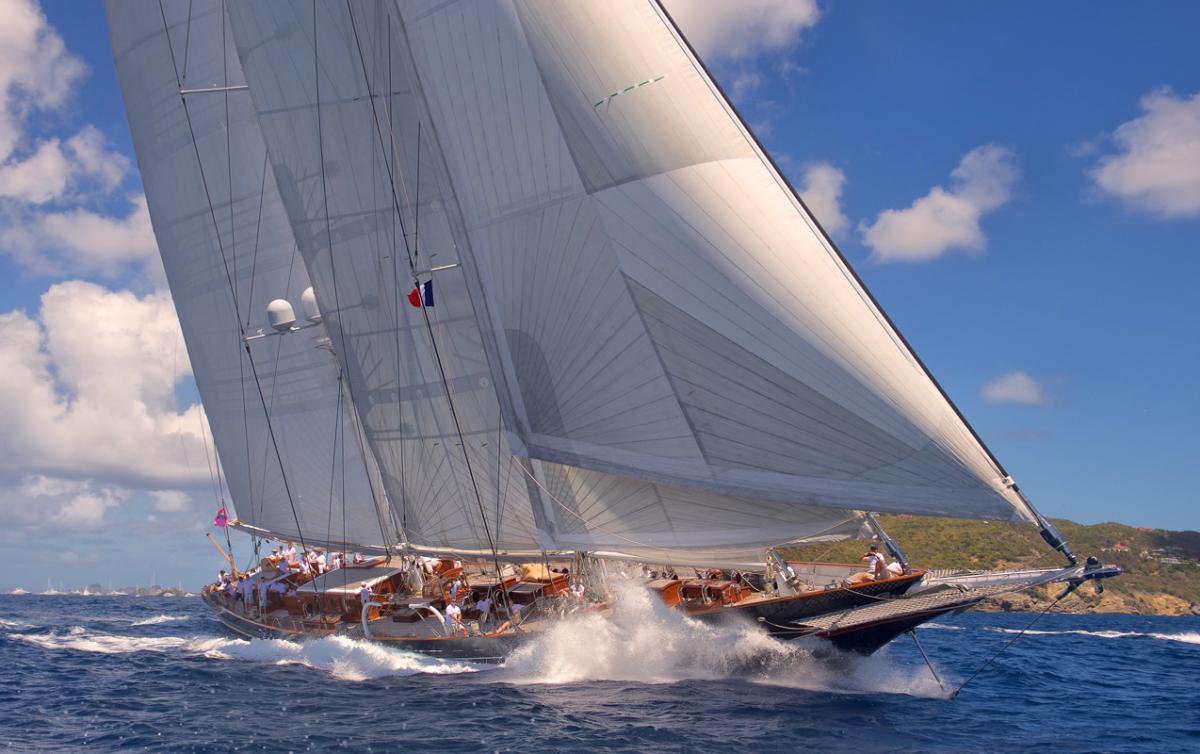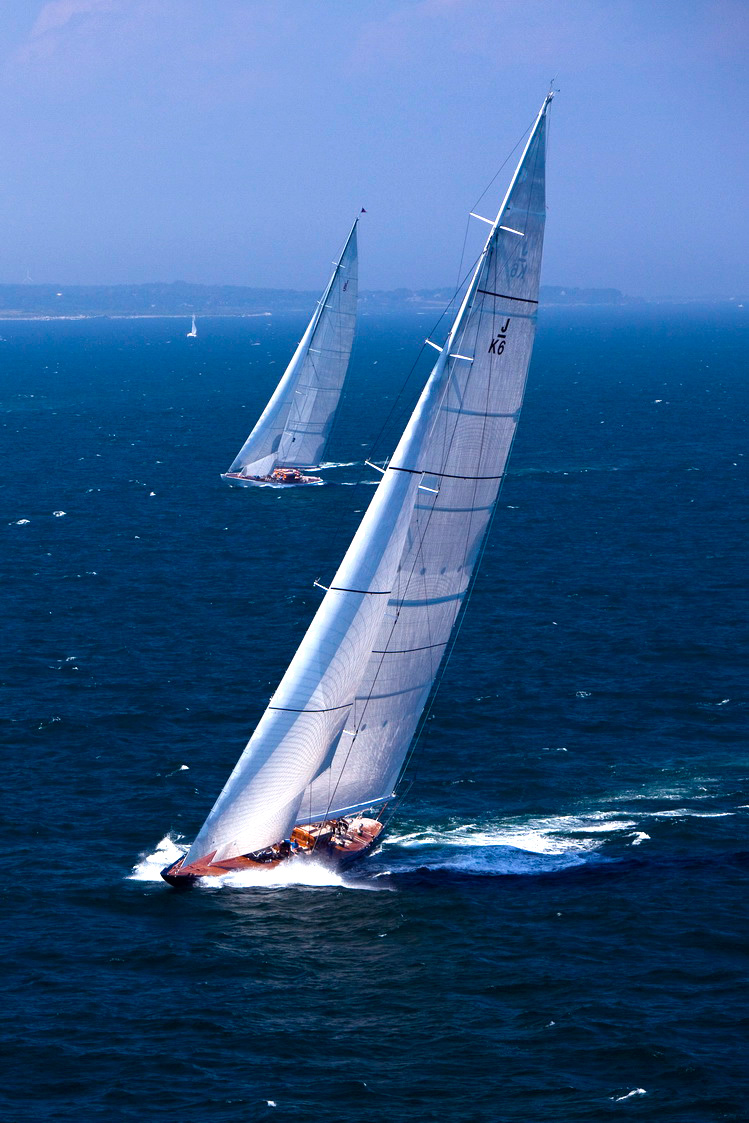Powering up the superyacht circuit
Superyachts are synonymous with high-comfort cruising but, increasingly, owners are asking shipbuilders to design super slick vessels matching envy-making comforts with a hard-edge racing pedigree. Mike Owens reports
To a yachtsman racing is innate, even when not acknowledged. Get onto the water to destress, we tell ourselves. Then it all goes to pot. It's a fact of life: one boat sails, two boats race! So if ever there's another sail in view, the race is on, the helmsman suddenly finding fresh focus, the crew newly alert, tweaking sail controls, looking for gains and the lead. From dinghy to superyacht it's the same. Always has been. That's how the America's Cup and its early, mighty combatants with their vast spreads of sail came to be. So simple. Two egos from two nations sailed, met and… determined to top the other.
World wars and troubled economies stalled this race to the biggest, but in different guise it is back. While the Auld Mug is now fought for on sci-fi foiling catamarans, and alternative grand prix sailing is in stripped out specialist machines akin to bare-knuckle fighting, beyond these extremes, never in the history of yachting have so many big yachts raced as today. All thanks to the increasingly tempting, dedicated superyacht regattas, now including St Barths, Antigua, the British Virgin Islands, Palma, Porto Cervo, Falmouth, Auckland and more, with variously sized fleets between five and 40-plus (turn to page 56 for our regatta special). Each presents a spectacular show, and a challenge not just to participants, but to organisers.
The maxim has to be safe, fair racing, as a T-boned, $50 million yacht amuses neither owner nor insurer. And it's no simple task with a fleet as diverse as this, from slow turning, heavy flybridge cruisers to modern more race-purposed, spin-on-the-spot lightweight rockets. They're all drop-dead gorgeous, beyond the dreams of most, and all very different. It's taken time to get the organisational balance right and, under the auspices of the collaborative SuperYacht Racing Association (SYRA), the wrinkles are flattening and the fleet is happier and growing.
As Peter Craig, race director at the St Barths Bucket and executive at SYRA, says: “We feel we're really getting a handle on safety and are now spending equal time on the fair racing component.”
With such variance in boat characteristics and the impact of this, racing is under an evolving handicapping system. It's a complicated business. Everything affects performance: tankage, displacement, windage above deck, hull shape, radar domes, sail plans, all that and more, and accurate information can be hard for the less race orientated to deliver.
Last year saw a new methodology introduced which all major events have now adopted. Craig picks up the story, “With the new, more transparent [Offshore Racing Congress Superyacht - ORCsy] rule, the ORC has done a pretty good job of getting these disparate boats right, or nearly right, straight out of the box. Nobody is saying the rule is perfect… is any handicap rule? It will take time but I am very pleased with where we are.”
Commissioning owners are also now increasingly looking for more race course performance. They still want fabulous on-board comforts but are demanding improved speed both through the water and manoeuvres. It's driving design and engineering to new levels, in hull and foil design, rigs, line handling, and power systems.

Dutch naval architect Andre Hoek grew his studio through developing what appear truly classic designs, but with thoroughly modern innovative systems, structures, and underwater profiles. The pilot cutter styled 52-metre ketch Elfje launched in 2014 is the perfect demonstration. Her commissioning owner gave Hoek's team the rare chance to spend six months in research. From this they completely readdressed their approach. As Hoek says, “It was a great opportunity. We developed six different hulls with different distributions of volume to see what would be potentially better for resistance and efficiency. We computer modelled extensively and tank tested with a 6-metre scale model, and only when we knew the optimal distribution of volume and shape did we then start to optimise the stability and structure, the keel, the rudder, and the sail plan.”
What they had done was develop an entirely new structural approach which the builders Royal Huisman executed in aluminium to extraordinary effect creating a fast, stiff, light yet still beautifully quiet boat. Low noise and vibration is the absolute priority in superyacht comfort and ever harder to achieve when weight is stripped out for speed as preventive measures introduce their own engineering and weight issues. To grasp the full effect of this, you need to sail a stripped-down grand prix race boat just once to realise how deafening an unprotected new-age build can be.
Royal Huisman have collaborated with another Dutch designer Dykstra Naval Architects on a number of projects for clients seeking this combination of high-performance racing and classic design. Yachts like J Class yachts Endeavour and Hanuman; 37-metre sloop Pumula; the schooners Athena (90 metres) and Meteor (52 metres); and the plumb bow 55-metre ketch Kamaxitha (launched in 2012), have proven to be regatta and award-winning yachts.
Managing director Thys Nikkels says many experienced owners come to Dykstra Naval Architects for high-performance yachts combined with classic looks and feel.
“It all starts with the comprehensive hands-on sailing/racing experience of the Dykstra team, extensive testing, and in-house developed programs. This also led to the design of the 66-metre ketch Hetairos, whose owner wanted to move towards extreme performance sailing and had the full carbon fibre vessel built at Baltic Yachts.” Hetairos was launched in 2011 and broke the Royal Ocean Racing Club 600 record in early 2012.
Baltic Yachts chief executive Henry Hawkins has long experience of this desire for performance. Very different to aluminium builders Royal Huisman, Hawkins' company specialises in carbon fibre construction for superyachts. He also has much experience of owners taking that step up the performance ladder. “One of the first questions we ask,” Hawkins says, “is will you be competing and with what expectations? We're known as a performance-orientated company and our buyers look for lighter weights, but with that little old thorn in the side, they want them quieter. If I look at recent boats delivered, all but one confirmed from the very beginning that they'll see the race course. So that's in our minds from the very start with design, construction, structural drawings, right through to deck layout, and hydraulic systems for line handling speeds.”
One who took that step with Baltic Yachts was the commissioning owner of the 33-metre WinWin; and it was quite some transition. After a comparatively genteel entry to superyachting with the 29-metre Jongert-built Scorpione dei Mari, he dipped a toe into the regatta scene, focusing initially on the Superyacht Cup in Palma, and became hooked and looked to his boat's name climbing onto the leaderboard. By chance, Mallorcan Javier Jaudenes, a sailor and designer of some renown, jumped aboard as crew and helped make that happen. Raised hopes and a subsequent visit to Baltic Yachts opened a new way of life, Javier and Baltic together created a cleverly combined sleek contemporary hybrid perfect for race course and family cruising.
Hawkins adds, “By the time this all happened Scorpione was as competitive as she possibly could be. She was sailed very, very well, and was victorious on occasion. That's where the drive came from and coming to us was a clear statement of what was wanted. I understand they're very pleased with the numbers they're getting back.”
 At times, the conversion, or at least a refit, is initially driven by a single issue, for example line speed on winches. The J Class resurgence emphasises the point – there are more of these splendid classics, original and recreated, afloat now than in their heyday in the 1930s.
At times, the conversion, or at least a refit, is initially driven by a single issue, for example line speed on winches. The J Class resurgence emphasises the point – there are more of these splendid classics, original and recreated, afloat now than in their heyday in the 1930s.
“Endeavour, Velsheda, Ranger, Shamrock are all the same sort of era with basically the same hydraulic packages,” says Steve Branagh of Marine Hydraulic Solutions. “When everyone's pulling spinnakers up to the top of the rig in 45 seconds then you're all in the same boat as it were. But when the likes of Lionheart, Hanuman, and Rainbow [or just launched Topaz] turn up and get the kite up the 60-metre rig in under 20 seconds, it all changes. At that top mark, first boat in with kite up in under 20 seconds is gone... and if Velsheda's there waiting another 25 seconds for the kite to fill then they're going to get passed. It becomes an arms race. None of these owners likes being beaten, none of them wants to have a slower boat, so everyone starts spending money. So we refitted Velsheda.”
With sheets (ropes controlling sail angle) it's the same story. They are reeling off winches at 100-plus metres a minute, and with often 14 tonne loads or more, the loads on these racing machines are huge. Elfje, mentioned earlier, has a carbon bowsprit rated to 150 tons compression.
Aboard the Dykstra-designed, Royal Huisman-built, 52-metre schooner Meteor, one owner details the logic. A lifelong sailor he raced with friends and volunteers but needed to up his game and was introduced to Olympic and America's Cup sailor John Kolius. He saw the opportunity and hired him. Next came some of the New Zealand team, and sailing half-and-half pro and amateur, the skills 'cascaded' down and the game improved, both in safety and pace. Pro crews tend also to be the only answer for boats regularly racing. With a preference for consistent, practised crew, and each regatta taking around 10 days with travel and training, friends and family simply run out of leave too quickly.
Has this level of crewing and virtually every sailing superyacht built today engineered to race well and in a way unimagined ten or 15 years ago, meant the original friendly spirit of the regattas is forever gone? Not at all, with very carefully considered class divisions, there are still different levels of racing within a single regatta and it's now very much safer to hurl your 150ft, 300 ton, $45 million yacht into the melee converging on that turning mark at 20 knots plus!
As Kate Branagh, race director of the Superyacht Cup Palma, says, “There are still two different camps. Those with competition as their priority who, in the pursuit of winning, base every decision on that, investing in the best crew, the best sails, and constantly upgrading everything. Then there are those who just like their cruising and come to regattas to enjoy sailing with friends and have a good day out on the water. It's not all going 100% towards performance. There's still very much a split in people's desire. It's really important to keep the appeal broad and not alienate anyone.”
Whichever camp you're in, you can't help but stare and compare. Last year's lead innovator and major owner upgrade was Perseus^3 from Perini Navi, the world's third tallest sloop carrying the single biggest sail ever made (her A2 is 2,600 sq m). This year's wonders include the new Frers designed Unfurled, a 46-metre aluminium featherweight flyer built by Vitters. The first Unfurled impressed. This will again… and more. Welcome to superyacht racing.






